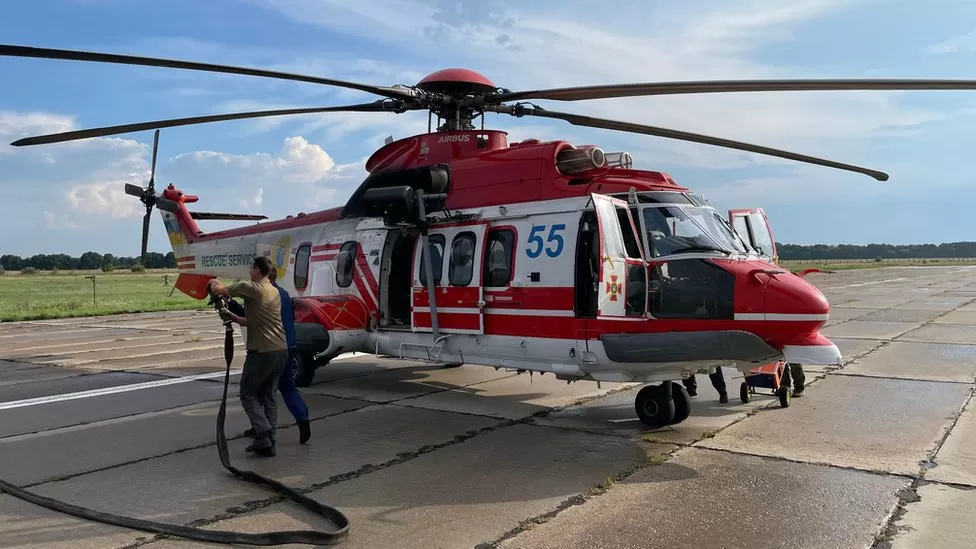
Even by the standards of Russia’s brutal invasion, this has been a bruising week for Ukraine. A devastating missile strike in Dnipro where 45 people died was followed by a helicopter crash near Kyiv, which killed 14. The crash claimed the lives of three senior officials,including Ukraine’s Interior Minister Denys Monastyrskyy, who was travelling towards the front line.
He was making a journey ministers frequently take, in a conflict where they’ve tried to be as visible as possible.So, are these journeys worth the risk? ‘There are risks, but it’s important to inspire our fighters, feel the situation on the front line and make decisions first-hand,’ says Volodymyr Fesenko, a political expert from Ukraine’s Centre for political studies.
Because the Interior Ministry is responsible for the National Guard, emergency services and the police force, Mr Fesenko believes the risks for Denys Monastyrsky were higher than for other ministers.’It’s impossible to assess and forecast everything in advance. For those who travel by helicopter the risk exists, especially during the war,’ he says.
The cause of the crash in Brovary still isn’t known. Helicopter is often the method of choice for senior figures to travel around Europe’s biggest country. We experienced it ourselves when we joined a trip with Monastyrskyy’s Interior Ministry last summer, from Kyiv to the city of Zaporizhzia.
‘When the officials move faster, they can do more,’ points out Anton Herashchenko, a former MP who was an advisor to interior minister. Monastyrskyy used to be his assistant and consultant. ‘You wouldn’t travel to the US by ship, would you?’ Herashchenko says. At times it did feel like we were on a ship on choppy water – only the sea had been replaced with the green vastness of Ukraine. There’d be the occasional feeling of free fall as the helicopter vaulted over electricity pylons.
For the entire trip we travelled at tree-level. There were moments where it felt like we were going to scrape someone’s roof. The reason for our altitude? To avoid being detected by Russian forces.
‘Because their life is important for the defence of their country, they have some level of protection,’ explains Mr Herashchenko. ‘But no one is protected against a missile, like the one which hit the residential block in Dnipro’.
At the other end of our journey, Denys Monastyrskyy assessed troops taking part in drills in case of a radioactive leak. The nearby nuclear powerplant in the city of Enerhodar has long been under Russian control. He then took questions from journalists, before heading back to Kyiv. A 700-mile round trip.
I have seen Mr Monastyrskyy make several public appearances since Russia’s full-scale invasion. I remember his convoy suddenly pulling over in Kyiv’s Independence Square on 28 February. At the time it was feared Russia could be in the city at any moment, but it didn’t stop him from holding a short notice press conference.
‘Police officers, border guards and emergency workers are doing all they can to bring victory closer and faster,’ he told us.More recently I saw Mr Monastyrskyy arrive at the scene of a missile strike in Zaporizhizhia last September. Thirty-two people had been killed, there were fears of a second attack, but he still came.
As one official reminded us: ‘It’s dangerous for everyone in Ukraine at the moment, for ministers and anyone else.’Ukraine’s President Zelensky has also embraced the risks of being a wartime leader. Standout moments included his appearance in the liberated city Kherson on 14 November. The Russians had only pulled out a couple of days before and were just across the Dnipro River.
Before his landmark visit to Washington, Ukraine’s leader travelled to the eastern city of Bakhmut to address troops. At the time Russian forces were a mile or so away. Some of the heaviest fighting was happening there.
These visits are a stark contrast with Russian President Vladimir Putin’s more cautious approach of not visiting the front lines. He instead sends his deputies.’We are still here’ were the words of the Ukraine’s leader in a video message with his top team on the day after Russia invaded. He’d reportedly turned down an evacuation offer by the US. It’s set the tone ever since. -BBC
Comments